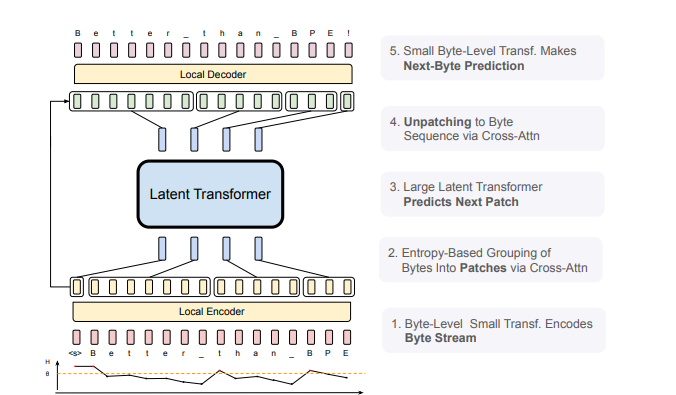Revolutionizing Language Models: The Byte Latent Transformer (BLT)
The panorama of synthetic intelligence, significantly in pure language processing (NLP), is present process a transformative shift with the introduction of the Byte Latent Transformer (BLT), and Meta’s newest analysis paper spills some beans about the identical. This modern structure, developed by researchers at Meta AI, challenges the standard reliance on tokenization in giant language fashions (LLMs), paving the best way for extra environment friendly and strong language processing. This overview explores the BLT’s key options, benefits, and implications for the way forward for NLP, as a primer for the daybreak the place in all probability tokens could be changed for good.

Figure 1: BLT Architecture: Comprised of three modules, a light-weight Local Encoder that encodes enter bytes into patch representations, a computationally costly Latent Transformer over patch representations, and a light-weight Local Decoder to decode the subsequent patch of bytes.
The Tokenization Problem
Tokenization has been a cornerstone in getting ready textual content knowledge for language mannequin coaching, changing uncooked textual content into a hard and fast set of tokens. However, this technique presents a number of limitations:
- Language Bias: Tokenization can create inequities throughout totally different languages, usually favoring these with extra strong token units.
- Noise Sensitivity: Fixed tokens battle to precisely symbolize noisy or variant inputs, which might degrade mannequin efficiency.
- Limited Orthographic Understanding: Traditional tokenization usually overlooks nuanced linguistic particulars which might be vital for complete language understanding.
Introducing the Byte Latent Transformer
The BLT addresses these challenges by processing language immediately on the byte degree, eliminating the necessity for a hard and fast vocabulary. Instead of predefined tokens, it makes use of a dynamic patching mechanism that teams bytes based mostly on their complexity and predictability, measured by entropy. This permits the mannequin to allocate computational sources extra successfully and concentrate on areas the place deeper understanding is required.
Key Technical Innovations
- Dynamic Byte Patching: The BLT dynamically segments byte knowledge into patches tailor-made to their data complexity, enhancing computational effectivity.
- Three-Tier Architecture:
- Lightweight Local Encoder: Converts byte streams into patch representations.
- Large Global Latent Transformer: Processes these patch-level representations.
- Lightweight Local Decoder: Translates patch representations again into byte sequences.
Key Advantages of the BLT
- Improved Efficiency: The BLT structure considerably reduces computational prices throughout each coaching and inference by dynamically adjusting patch sizes, resulting in as much as a 50% discount in floating-point operations (FLOPs) in comparison with conventional fashions like Llama 3.
- Robustness to Noise: By working immediately with byte-level knowledge, the BLT displays enhanced resilience to enter noise, making certain dependable efficiency throughout numerous duties.
- Better Understanding of Sub-word Structures: The byte-level strategy permits for capturing intricate particulars of language that token-based fashions might miss, significantly useful for duties requiring deep phonological and orthographic understanding.
- Scalability: The structure is designed to scale successfully, accommodating bigger fashions and datasets with out compromising efficiency.

Figure 2: BLT makes use of byte n-gram embeddings together with a cross-attention mechanism to reinforce the stream of data between the Latent Transformer and the byte-level modules (see Figure 5). In distinction to fixed-vocabulary tokenization, BLT dynamically organizes bytes into patches, thereby sustaining entry to byte-level data.
Experimental Results
Extensive experiments have demonstrated that the BLT matches or exceeds the efficiency of established tokenization-based fashions whereas using fewer sources. For occasion:
- On the HellaSwag noisy knowledge benchmark, Llama 3 achieved 56.9% accuracy, whereas the BLT reached 64.3%.
- In character-level understanding duties like spelling and semantic similarity benchmarks, it achieved near-perfect accuracy charges.
These outcomes underscore the BLT’s potential as a compelling various in NLP functions.
Real-World Implications
The introduction of the BLT opens thrilling potentialities for:
- More environment friendly AI coaching and inference processes.
- Improved dealing with of morphologically wealthy languages.
- Enhanced efficiency on noisy or variant inputs.
- Greater fairness in multilingual language processing.
Limitations and Future Work
Despite its groundbreaking nature, researchers acknowledge a number of areas for future exploration:
- Development of end-to-end realized patching fashions.
- Further optimization of byte-level processing methods.
- Investigation into scaling legal guidelines particular to byte-level transformers.
Conclusion
The Byte Latent Transformer marks a big development in language modeling by transferring past conventional tokenization strategies. Its modern structure not solely enhances effectivity and robustness but additionally redefines how AI can perceive and generate human language. As researchers proceed to discover its capabilities, we anticipate thrilling developments in NLP that may result in extra clever and adaptable AI methods. In abstract, the BLT represents a paradigm shift in language processing-one that might redefine AI’s capabilities in understanding and producing human language successfully.
The submit Revolutionizing Language Models: The Byte Latent Transformer (BLT) appeared first on Datafloq.

